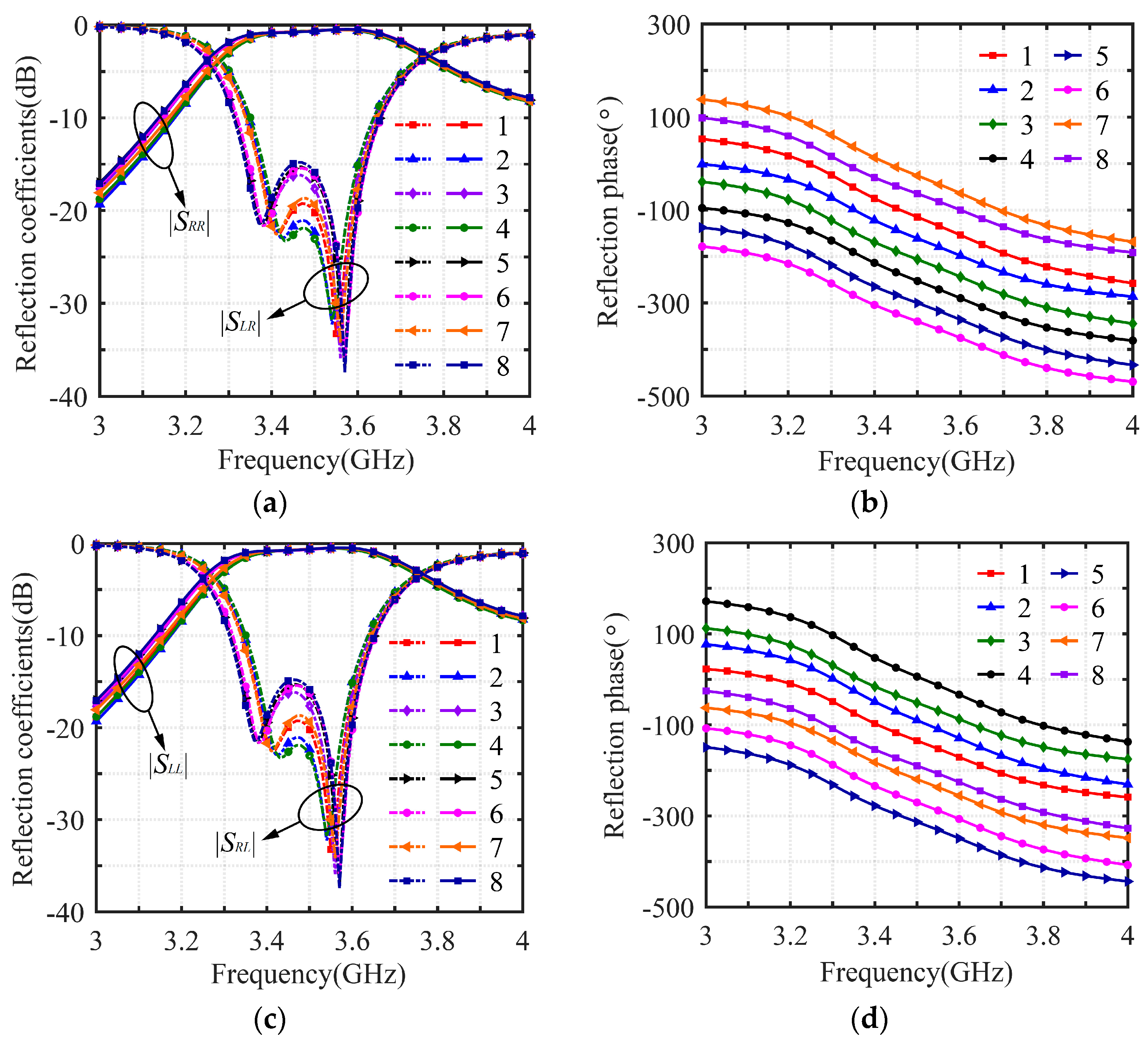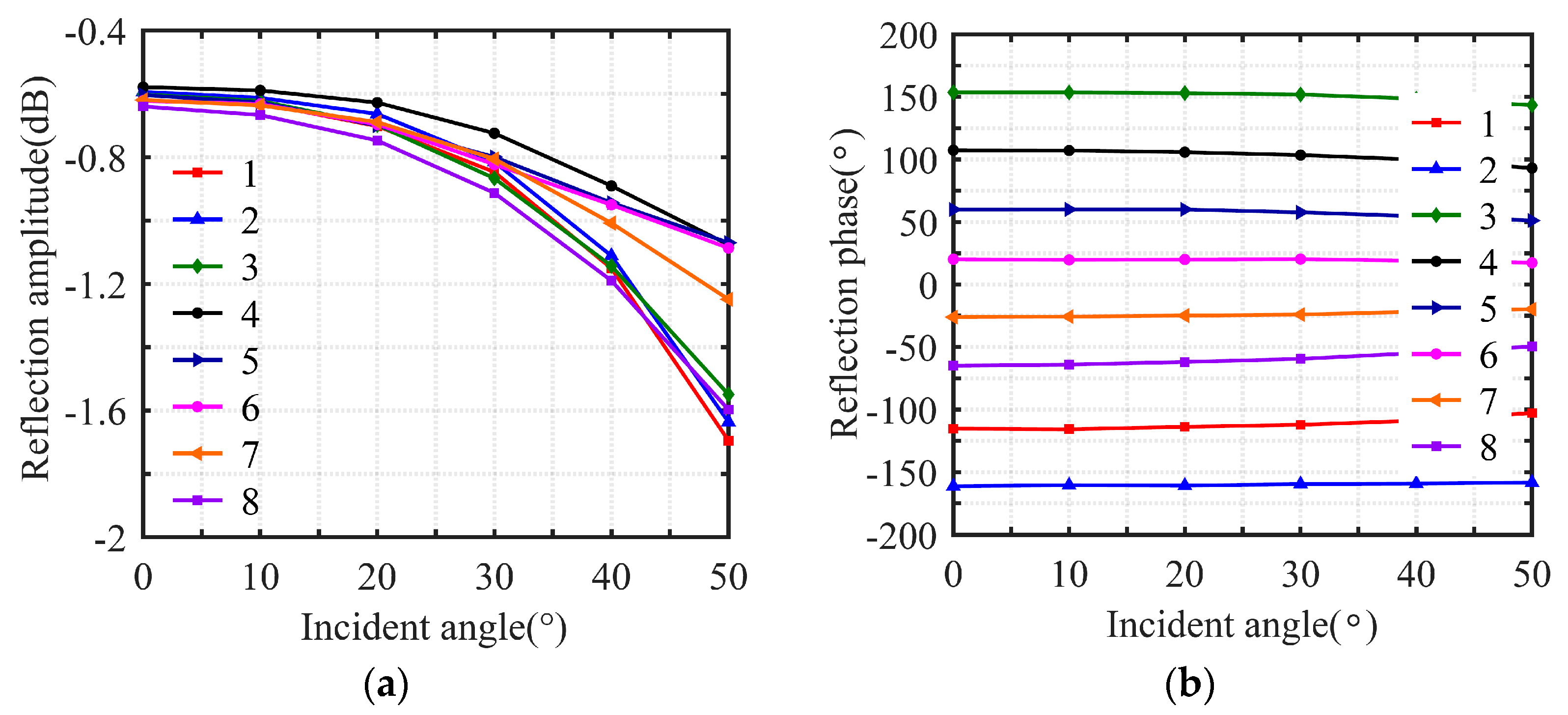Design of a 3-Bit Circularly Polarized Reconfigurable Reflectarray
Abstract
:1. Introduction
2. Materials and Methods
2.1. Extraction of Equivalent Circuit Model of PIN Diode
2.2. Design of Circularly Polarized Reconfigurable Reflectarray Unit
2.3. Design of 3-Bit Circularly Polarized Reconfigurable Reflectarray
3. Fabrication and Measurement Results
4. Conclusions
Author Contributions
Funding
Data Availability Statement
Conflicts of Interest
References
- Yahya, R.S.; Junbo, W. A 7 m × 1.5 m Aperture Parabolic Cylinder Deployable Mesh Reflector Antenna for Next-Generation Satellite Synthetic Aperture Radar. IEEE Trans. Antennas Propag. 2023, 71, 6378–6389. [Google Scholar]
- Wu, Q.L.; Jiang, X.F. Attenuation of Orbital Angular Momentum Beam Transmission with a Parabolic Antenna. IEEE Antennas Wirel. Propag. Lett. 2021, 20, 1849–1853. [Google Scholar] [CrossRef]
- Zhang, Z.Y.; Zhao, Y.R. Design of a Dual-Beam Dual-Polarized Offset Parabolic Reflector Antenna. IEEE Trans. Antennas Propag. 2019, 67, 712–718. [Google Scholar] [CrossRef]
- Zhang, S.X.; Duan, B.Y. Random Error Characterization of Nonsmooth Parabolic Reflector Antennas with Gore-Faceted or Discontinuous Surface. IEEE Trans. Antennas Propag. 2021, 69, 1922–1930. [Google Scholar] [CrossRef]
- Vignesh, M.; Yahya, R.S. Understanding the Radiation Characteristics of Metal-Only, Low-Profile, Offset Stepped Parabolic Reflector Antennas: Simulation, Analysis, and Measurement. IEEE Trans. Antennas Propag. 2021, 69, 5078–5083. [Google Scholar]
- Cho, H.Y.; Jo, H.W.; Kin, J.W. Shorted Trapezoidal SIW Antenna with Quasi-Hemispherical Pattern for 2D Wide Scanning Planar Phased Array Antenna. IEEE Trans. Antennas Propag. 2022, 70, 7211–7216. [Google Scholar] [CrossRef]
- Li, A.; Qu, S.W.; Yang, S.W. Conformal Array Antenna for Applications in Wide-Scanning Phased Array Antenna Systems. IEEE Antennas Wireless Propag. Lett. 2021, 9, 1762–1766. [Google Scholar] [CrossRef]
- Kim, J.W.; Chae, S.C.; Jo, H.W. Wideband Circularly Polarized Phased Array Antenna System for Wide Axial Ratio Scanning. IEEE Trans. Antennas Propag. 2022, 70, 1523–1528. [Google Scholar] [CrossRef]
- Peng, J.J.; Qu, S.W.; Xia, M.Y.; Yang, S.W. Wide-Scanning Conformal Phased Array Antenna for UAV Radar Based on Polyimide Film. IEEE Antennas Wirel. Propag. Lett. 2020, 19, 1581–1585. [Google Scholar] [CrossRef]
- Chen, Q.; Yan, S.L.; Guo, X.Y. A 77 GHz Phased Array Antenna Based on Substrate-Integrated Waveguide. IEEE Antennas Wirel. Propag. Lett. 2023, 22, 2979–2983. [Google Scholar] [CrossRef]
- Amir, R.; Ardeshir, P.; Ahmad, E. A Low-Profile 2D Passive Phased-Array Antenna-in-Package for Emerging Millimeter-Wave Applications. IEEE Trans. Antennas Propag. 2023, 71, 1093–1098. [Google Scholar]
- Theng, H.G.; Liu, A.K.; Tan, P.K. A Bendable Wideband Dual-Polarization Conformal Phased-Array Antenna. IEEE Antennas Wirel. Propag. Lett. 2023, 22, 1952–1956. [Google Scholar]
- Dai, J.Y.; Tang, W. Wireless Communication Based on Information Metasurfaces. IEEE Trans. Microw. Theory Tech. 2021, 69, 1493–1510. [Google Scholar] [CrossRef]
- Wu, Q.; Zhang, S.; Zheng, B. Intelligent Reflecting Surface-Aided Wireless Communications: A Tutorial. IEEE Trans. Commun. 2021, 69, 3313–3351. [Google Scholar] [CrossRef]
- Cui, T.J.; Liu, S.; Bai, G.D. Direct Transmission of Digital Message via Programmable Coding Metasurface. Research 2019, 2019, 2584509. [Google Scholar] [CrossRef] [PubMed]
- Dai, J.Y.; Tang, W.; Yang, L.X. Realization of Multi-Modulation Schemes for Wireless Communication by Time-Domain Digital Coding Metasurface. IEEE Trans. Antennas Propag. 2020, 68, 1618–1627. [Google Scholar] [CrossRef]
- Zhang, L.; Wang, Z.X.; Shao, R.W. Dynamically Realizing Arbitrary Multi-Bit Programmable Phases Using a 2-Bit Time-Domain Coding Metasurface. IEEE Trans. Antennas Propag. 2020, 68, 2984–2992. [Google Scholar] [CrossRef]
- Lin, S.; Zheng, B. Reconfigurable Intelligent Surfaces with Reflection Pattern Modulation: Beamforming Design and Performance Analysis. IEEE Trans. Wirel. Commun. 2021, 20, 741–754. [Google Scholar] [CrossRef]
- Yang, X.; Xu, S.; Yang, F. A Mechanically Reconfigurable Reflectarray with Slotted Patches of Tunable Height. IEEE Trans. Antennas Propag. 2018, 17, 555–558. [Google Scholar] [CrossRef]
- Mei, P.; Zhang, S. A Wideband 3-D Printed Reflectarray Antenna with Mechanically Reconfigurable Polarization. IEEE Trans. Antennas Propag. 2020, 19, 1798–1802. [Google Scholar] [CrossRef]
- Mei, P.; Zhang, S. A Low-Cost, High-Efficiency and Full-Metal Reflectarray Antenna with Mechanically 2-D Beam-Steerable Capabilities for 5G Applications. IEEE Trans. Antennas Propag. 2020, 68, 6997–7006. [Google Scholar] [CrossRef]
- Kong, G.; Li, X.; Wang, Q. A Wideband Reconfigurable Dual-Branch Helical Reflectarray Antenna for High-Power Microwave Applications. IEEE Trans. Antennas Propag. 2021, 69, 825–833. [Google Scholar] [CrossRef]
- Pan, X.; Yang, F.; Xu, S. A 10240-Element Reconfigurable Reflectarray with Fast Steerable Monopulse Patterns. IEEE Trans. Antennas Propag. 2021, 69, 173–181. [Google Scholar] [CrossRef]
- Wu, F.; Lu, R.; Wang, J. Circularly Polarized One-Bit Reconfigurable ME-Dipole Reflectarray at X-Band. IEEE Antennas Wirel. Propag. Lett. 2022, 21, 496–500. [Google Scholar] [CrossRef]
- Wu, F.; Lu, R.; Wang, J. A Circularly Polarized 1 Bit Electronically Reconfigurable Reflectarray Based on Electromagnetic Element Rotation. IEEE Trans. Antennas Propag. 2021, 69, 5585–5595. [Google Scholar] [CrossRef]
- Han, J.; Li, L.; Ma, X. Adaptively Smart Wireless Power Transfer Using 2-Bit Programmable Metasurface. IEEE Trans. Ind. Electron. 2022, 69, 8524–8534. [Google Scholar] [CrossRef]
- Liao, J.; Guo, S.; Yuan, L. Independent Manipulation of Reflection Amplitude and Phase by a Single-Layer Reconfigurable Metasurface. Adv. Opt. Mater. 2022, 10, 2101551. [Google Scholar] [CrossRef]
- Xu, J.; Liu, W. Terahertz Dynamic Beam Steering Based on Graphene Coding Metasurfaces. IEEE Photonics J. 2021, 13, 1–9. [Google Scholar] [CrossRef]
- Chen, D.; Yang, J.; Huang, J. Continuously tunable metasurfaces controlled by single electrode uniform bias-voltage based on nonuniform periodic rectangular graphene arrays. Optics Express. 2020, 28, 29306. [Google Scholar] [CrossRef]
- Li, R.; Liu, H. Light-controlled metasurface with a controllable range of reflection phase modulation. J. Phys. D Appl. Phys. 2022, 55, 225302. [Google Scholar] [CrossRef]
- Luo, W.; Yu, S.; Kou, N. Design of Height-Adjustable Mechanically Reconfigurable Reflectarray. Prog. Electromagn. Res. Lett. 2022, 104, 1–6. [Google Scholar] [CrossRef]
- Xi, B.; Xiao, Y. 1-Bit Wideband Reconfigurable Reflectarray Design in Ku-Band. IEEE Access 2022, 10, 4340–4348. [Google Scholar] [CrossRef]
- Baladi, E.; Xu, M.Y.; Faria, N. Dual-Band Circularly Polarized Fully Reconfigurable Reflectarray Antenna for Satellite Applications in the Ku-Band. IEEE Trans. Antennas Propag. 2021, 69, 5585–5595. [Google Scholar] [CrossRef]
- Zhang, X.G.; Jiang, W.X.; Jiang, H.L. An optically driven digital metasurface for programming electromagnetic functions. Nature Electron. 2020, 3, 165–171. [Google Scholar] [CrossRef]
- Chen, L.; Nie, Q.F.; Ruan, Y. Thermal sensing metasurface with programmable wave-front manipulation. J. Appl. Phys. 2020, 128, 075105. [Google Scholar] [CrossRef]
- Yang, H.H.; Yang, F.; Xu, S.H. A 1-Bit Multipolarization Reflectarray Element for Reconfigurable Large-Aperture Antennas. IEEE Antennas Wirel. Propag. Lett. 2017, 16, 581–584. [Google Scholar] [CrossRef]
- Javor, R.; Wu, X.D.; Chang, K. Design and performance of a microstrip reflectarray antenna. IEEE Trans. Antennas Propag. 1995, 43, 932–939. [Google Scholar] [CrossRef]
- Fan, Y.L.; Lin, X.Q.; Yang, X.M. Reconfigurable Design of a Polarization-Decoupled Dual-Circularly Polarized Reflectarray. IEEE Trans. Antennas Propag. 2023, 71, 10020–10025. [Google Scholar] [CrossRef]
- Trampler, M.E.; Lovato, R.E.; Gong, X. Dual-Resonance Continuously Beam-Scanning X-Band Reflectarray Antenna. IEEE Trans. Antennas Propag. 2020, 68, 6080–6087. [Google Scholar] [CrossRef]
- Zhang, M.T.; Gao, S.; Jiao, J.C. Design of Novel Reconfigurable Reflectarrays with Single-bit Phase Resolution for Ku-Band Satellite Antenna Applications. IEEE Trans. Antennas Propag. 2016, 64, 1634–1641. [Google Scholar] [CrossRef]
- Liu, H.; Fan, Y.L.; Xing, Y. Wideband circularly polarized SIW cavity-backed patches antenna for wide-angle scanning phased arrays. Microw. Opt. Technol. Lett. 2023, 66, 1–8. [Google Scholar] [CrossRef]

















| Calculated compensation phase (°) | [−22.5, 22.5] | [22.5, 67.5] | [67.5, 112.5] | [112.5, 157.5] |
| Quantized compensation phase | 0 | 45 | 90 | 135 |
| Calculated compensation phase (°) | [157.5, 202.5] | [202.5, 247.5] | [247.5, 292.5] | [292.5, 337.5] |
| Quantized compensation phase | 180 | 225 | 270 | 315 |
| References | [39] | [40] | [25] | [41] | This Work |
|---|---|---|---|---|---|
| Reconfigurable technology | varactor | PIN diode | PIN diode | phased array | PIN diode |
| Number of phase shifts | continuous | 1-bit | 1-bit | / | 3-bit |
| Polarization | linear | Circular | circular | circular | circular |
| Number of diodes | 4 | 4 | 2 | / | 8 |
| Loss of unit | <4 dB | <1 dB | <1 dB | <4.7 dB | <1 dB |
| Angular stability | 40° | / | 30° | / | 50° |
| Aperture efficiency | 25.42% | 15% | 20% | / | 27% |
| Scanning range | ±50°/±50° | ±40°/±40° | −30°~45°/±60° | ±60° | ±60°/±60° |
Disclaimer/Publisher’s Note: The statements, opinions and data contained in all publications are solely those of the individual author(s) and contributor(s) and not of MDPI and/or the editor(s). MDPI and/or the editor(s) disclaim responsibility for any injury to people or property resulting from any ideas, methods, instructions or products referred to in the content. |
© 2024 by the authors. Licensee MDPI, Basel, Switzerland. This article is an open access article distributed under the terms and conditions of the Creative Commons Attribution (CC BY) license (https://creativecommons.org/licenses/by/4.0/).
Share and Cite
Chen, Z.; Huang, C.; Yang, X.; Yan, X.; Lin, X.; Zhou, Y. Design of a 3-Bit Circularly Polarized Reconfigurable Reflectarray. Electronics 2024, 13, 1886. https://doi.org/10.3390/electronics13101886
Chen Z, Huang C, Yang X, Yan X, Lin X, Zhou Y. Design of a 3-Bit Circularly Polarized Reconfigurable Reflectarray. Electronics. 2024; 13(10):1886. https://doi.org/10.3390/electronics13101886
Chicago/Turabian StyleChen, Zhe, Chenlu Huang, Xinmi Yang, Xiaoming Yan, Xianqi Lin, and Yedi Zhou. 2024. "Design of a 3-Bit Circularly Polarized Reconfigurable Reflectarray" Electronics 13, no. 10: 1886. https://doi.org/10.3390/electronics13101886




